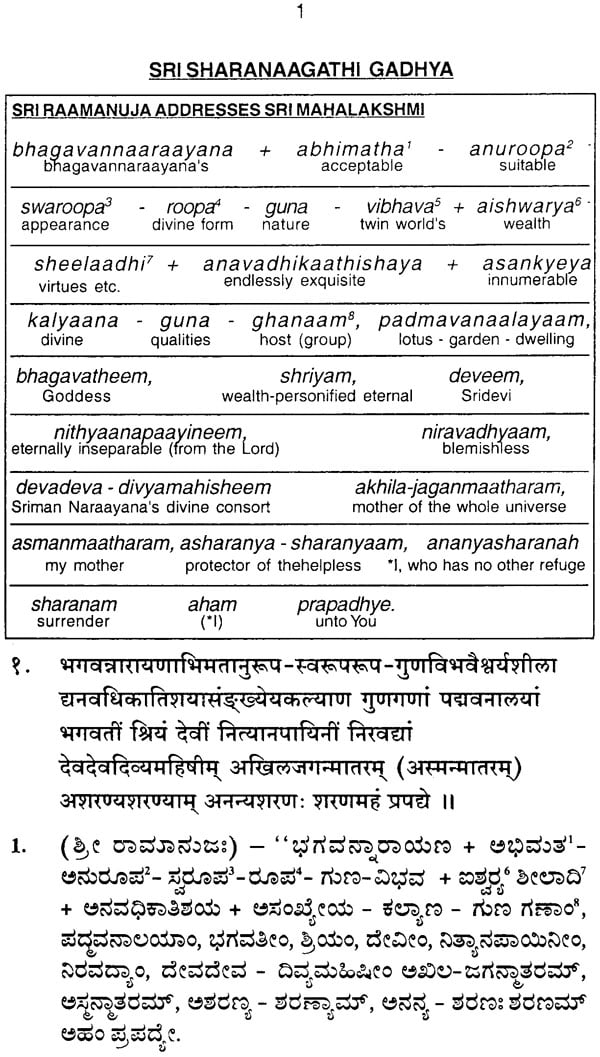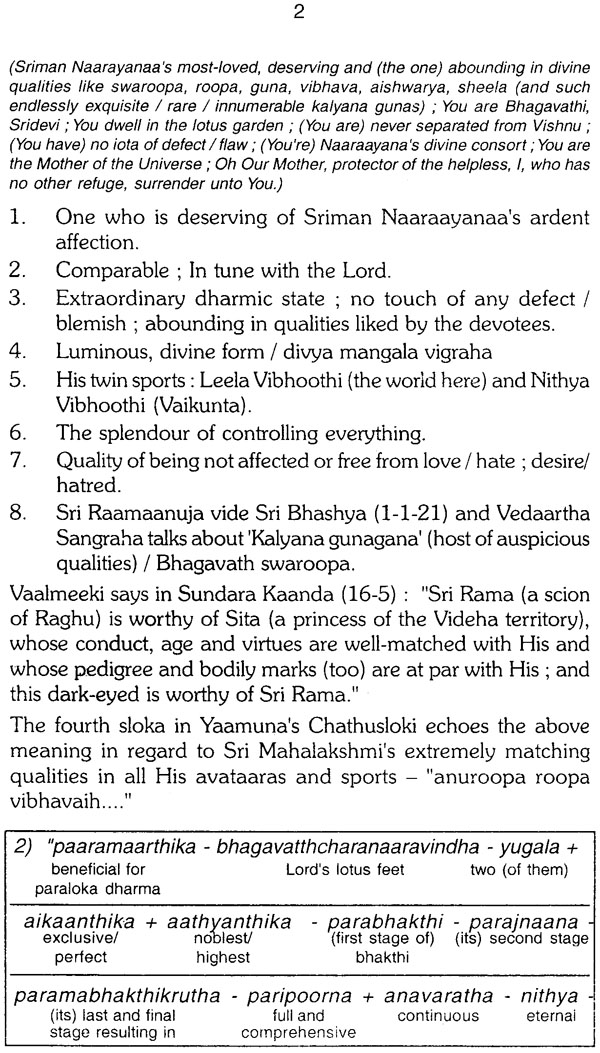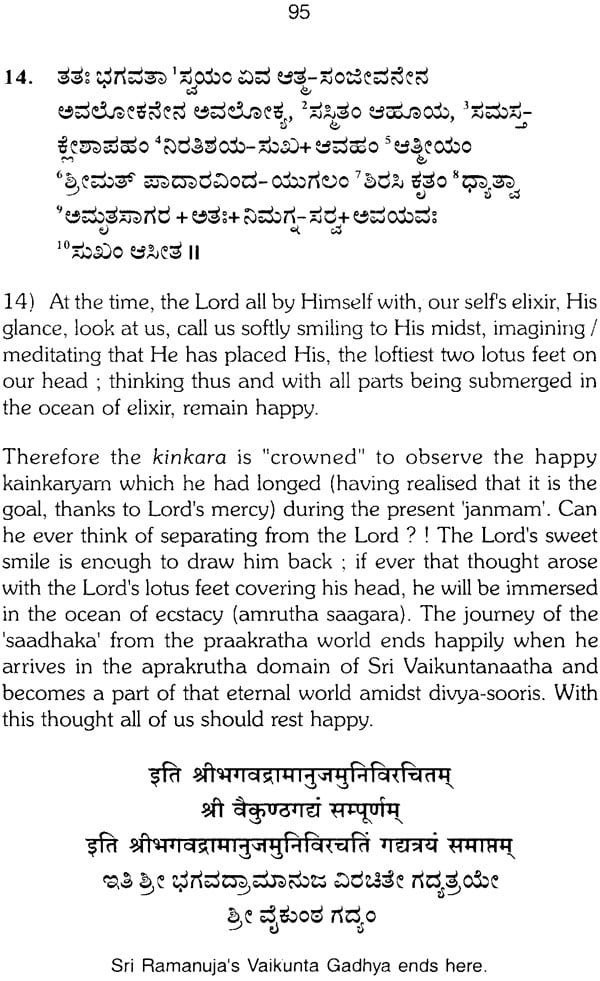
Shree Gadhya Trayam of Sri Ramanuja
Book Specification
| Item Code: | NAM377 |
| Author: | K. R. Krishnaswami |
| Publisher: | A & K PRAKASHANA |
| Language: | Sanskrit and Kannada Text With Word to Word Meaning English Translation |
| Edition: | 2021 |
| Pages: | 120 |
| Cover: | Paperback |
| Other Details | 8.5 inch x 5.5 inch |
| Weight | 140 gm |
Book Description
Sri Raamaanuja has composed nine works in all and Gadhya Traya happens to be his latter day composition. It is believed that his earlier works viz. Sribhashya, Gita bhashya, Vedantha Sangraha and others served as preparation for the blossoming of his concept of Sharanagathi resulting in the triple-prose viz. Sharanaagathi Gadhya, Sriranga Gadhya and Vaikunta Gadhya. Sharanagathi Gadhya is an extremely rare kind of work as it embodies a dialogue between Jeevaathman and Paramaathman, or the soul and Oversoul ; as someone put it : 'the fervour of the human soul throbbing with deep love and surrender to its Master has rarely found such expression' and 'there is a sense of certainity and an atmosphere of serenity'. Sharanaagathi Gadhya is therefore considered Sri Raamaanuja's swan song. Sharanaagathi Gadhya, scholars believe, lends itself to three divisions, each representing a rahasya viz. dvaya manthra, moola manthra and Gita charama sloka. Sharanaagathi Gadhya also highlights the Srivaishnava faith viz. the principle of mediation or intercession by Sri Mahalakshmi who pleads with the Lord for justice for the contrite soul (jeevaathma).
Sri Raamaanuja himself after decades of service to the Lord Ranganaatha does sharanaagathi at the feet of the Lord at Srirangam in Sriranga Gadhya. Once having done Sharanaagathi what does one achieve, or how he approaches the Lord, or the scene where he ends up for eternity are all answered by Sri Raamaanuja in his Vaikunta Gadhya.
In short, the theme of the Gadhya Traya is Sharanaagathi in all its aspects. Unlike bhakthi yoga, it is a simple, viable route accessible to everyone, weak or strong, learned or unlettered, noble or fallen. The process is a complete end in itself culminating in kainkaryam to the Lord at the Paramapada and enjoyment of the opulence of divine service.
I have thought it appropriate to present the 'moolam' - the original text in three languages: transcription in English, Kannada and of course, Sanskrit. An effort has been made to provide meanings of words (text) in English as they appear, and to join them as they are, to provide literal meaning of the text; besides, the substance of each stanza has been given wherever necessary. References to religious classics like Raamaayana, Vishnu Puraana, Bhagavad Geethaa, Divya Prabhandham have been given. It is hoped that this presentation will be found useful by the readers.
1. The Lord's Mercy: With a view to show the right path to the multitude of erring chethanas, the Lord, Sriman Naaraayana, overpowered by His quality of mercy has planned 'coming to this world' (avataaram), at various times through the medium of aachaaryas such as Naathamuni, Yaamunamuni, Sri Raamaanuja. Through them He engineers 'Ujjeevana' (realisation) of erring of devotees.
2. Poorvaachaarya's concern: Gadhya Traya is an excellent example of the concern felt by the Poorvaachaaryas of the calibre of Sri Raamaanuja for the common lot who are caught in the quagmire of 'samsaaric' life and are not able to extricate themselves being incapable of following rigorous practices of various Yogas like bhakthi Yoga. Gadhya Traya shows the way for attaining the lotus feet of the Lord at Vaikuntam and the route is available to all without distinction of caste or sex. This triple prose (which indeed are prose-poems!) are often compared to Sthothramaala of Sri Yaamunaacharya (who also had similar concerns for the common lot) - Sthothrarathna is also an expression of 'the nature and value' of Prapatthi.
3. Beatific Vision: We owe it to that important day of the Hindu Calendar viz. the Thirunakshathram festival of Sri Mahalakshmi (panguni-utthiram). Every year on that day the divya dampathies', i.e. Sri Ranganaathar's and Sri Mahalakshmi's divya mangala' idols are placed together for all the devotees to pray and receive the blessings. On one such occasion, Sri Raamaanuja, was found to have been lost in a trance in front of the divya dampathies. When he opened his eyes, what came out of his holy mouth were the details of his beatific vision of the Lord and His consort, Lord's response to Sri Raamaanuja's concern, a vision of the scene at Vaikunta, a comforting assurance and a confirmation of the path, accessible to everyone, which enables crossing the cycle of birth and death - in short, the Gadhya Traya, a rare product of divine interaction with our aachaarya!
4. The Routes and the Resort: Sriman Naaraayana is the resort of the resortless who is having -innumerable auspicious qualities and totally free from evil, hatred etc. He is of the nature of knowledge and bliss and is a treasure chest of effulgence, beauty, fragrance, softness, grace and everlasting youth.
He lives in Vaikunta, our final destination. The holy land, described in Vaikunta Gadhya, is a vast paradise which even Brahma or others have not been able to fathom. The master of that land is Sriman Naaraayana who is 'inscrutable' even to the highest of Yogins.
In order to achieve liberation from the endless cycle and to get over the sins from beginningless time, the routes as described in Bhagavad Geethaa are Karma Yoga, Bhakthi Yoga and Jnaana Yoga; in fact a combination of more than one Yoga. The Lord Himself has talked about the difficulties to practise these Yogas, and the much simpler Prapatthi Yoga is the only practical route to attain the lotus feet of the Lord.
5. Scriptures Advocate Sharanagathi: Rig Veda talks about Prapatthi, which means that it is as old as the oldest Veda. Taitthireeya Upanishad calls it as 'Nyaasa' and 'prescribes the manner in which it should be performed'....and declares it to be the best route to attain moksha. Other Upanishads like Svetaaswatara, Chandogya talk about Prapatthi.
Ramayana is considered a Sharanaagathi Veda - Sri Rama's 'abhaya pradhaana' to Vibhishana is a very significant juncture in Raamaayana which is extolled as a shrine of self-surrender. Gita (7-14, 16-61/62), Sri Vishnu Puraana (1-9-73), Paancharaathra Agama, Lakshmitanthra and Aazhwaar's Sri Sookthis advocate Sharanaagathi.
6. Commentaries Galore: Just as any other work of Sri Raamaanuja, Gadhya Traya has also attracted a large number of commentators writing bhashyas on it. Amongst the celebrated commentaries are those by Sudarshana Soori, Vedantha Desika and Peria Aachaan Pillai. Sharanaagathi Gadhya in particular has to its credit a large number of commentaries.
7. Post-liberation (moksha): The liberation consists in jeevaathma acquiring 'the flavour and fragrance of Brahman' (the Vedanthic term for the Lord); it gains brahma roopa, brahma rasa and brahma gandha. It is freed from the fetters of Prakrithi, limitations of space and time. It lives in nithya vibhoothi, the abode of Brahman, which has no history, no seasons but can all at once 'bear leaves blossoms and fruits' (ref. Shanthi Parva in Mahabhaaratha). Thus the jeeva attains, 'its infinite consciousness and regains the eternal values....it is indeed a state of self-transcendence'.
Paancharaathra calls it as 'jnaanaanandaloka'-that is, the world of Paramapadam is a shining example of the spiritual world; bliss personified, apraakrutha, aanandaloka ; it is the realm of shuddha satthva, a kind of matter which is immutable. The five elements which comprise us, will not touch us.
8. Rahasya Traya: Gadhya Traya embodies the concepts of the three sacred manthras, known as Rahasya Traya, which reflect the Vishistadvaitha concepts of tatthva, hita and purushaartha. They are moola manthra, dvaya manthra and Geetha charama sloka. It is generally stated that Sharanagathi Gadhya is a commentary on dvaya manthra.
Swa-nishte (daily recitation of the Gadhyas) : There are three ways of conducting Sharanaagathi:
(i) uktha nishte : repeating what the aachaarya utters on your behalf; in front of the Lord.
ii) aacharya nishte : On behalf of shishya, the aachaarya 'deposits' one's 'bhaara' in the Lord.
iii) Swa-nishte: One 'deposits' his protection aspect in the Lord by himself.
The last one is followed by Sri Raamaanuja in Sharanaagathi Gadhya. Therefore if one recites Sharanaagathi Gadhya everyday it is extremely beneficial.
| 1 | Acknowledgements | v |
| 2 | Preface | vii |
| 3 | Introduction | ix |
| 4 | The Gospel of Self-surrender | xii |
| 5 | Gadhya Traya's Base - The Rahasya Traya | xiv |
| i) Moola manthra | ||
| ii) Dvaya manthra | ||
| iii) Geetha Charama Sloka | ||
| 6 | Presentation of the Gadhyas by Raamaanuja | xix |
| 7 | Commentaries of Gadhya Traya | xxi |
| 8 | Elaboration of some key terms | xxii |
| 9 | Sri Sharanagathi Gadhya | 1 |
| 10 | Sri Sriranga Gadhya | 50 |
| 11 | Sri Vaikunta Gadhya | 66 |
| 12 | References | 96 |









